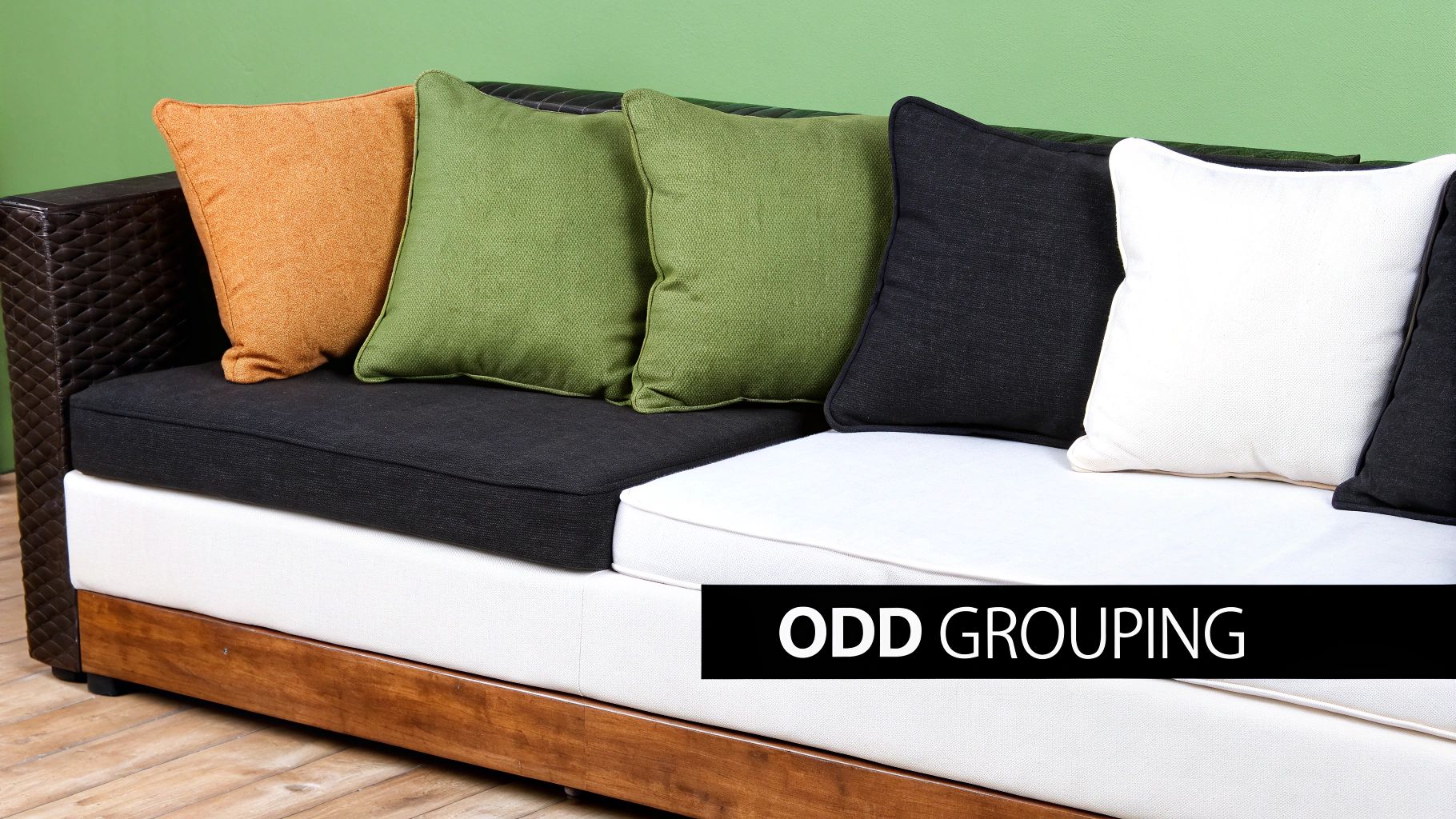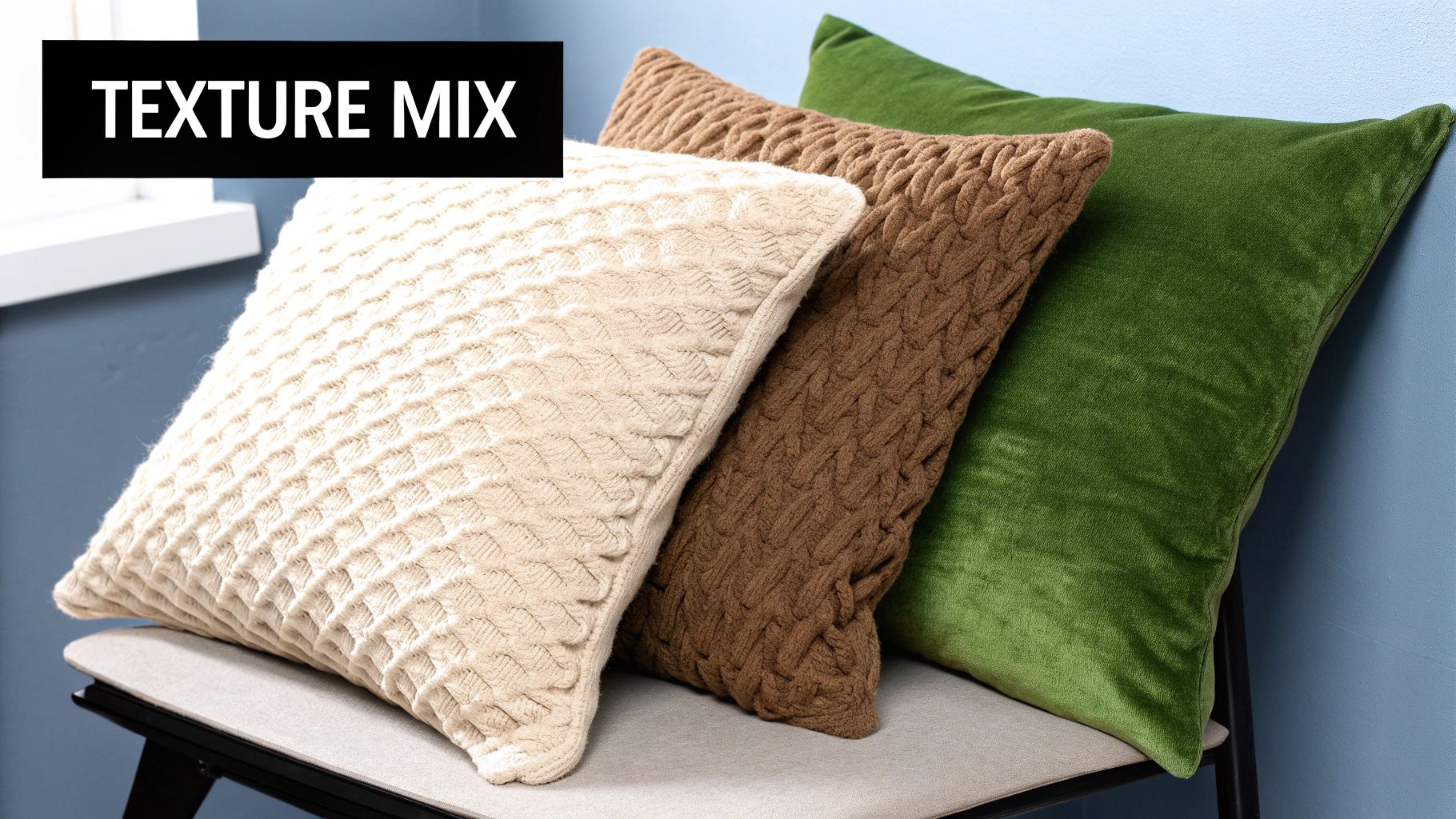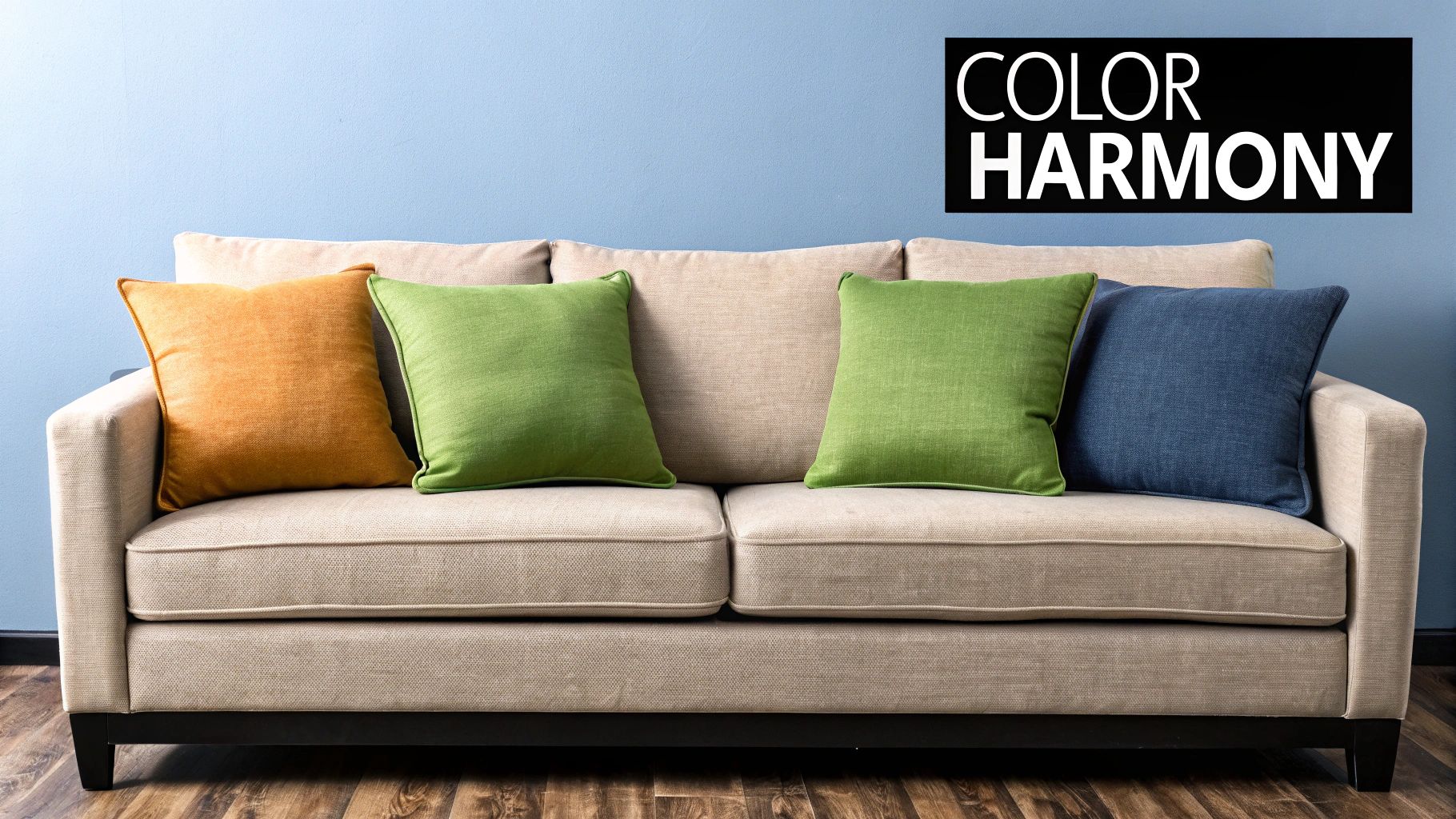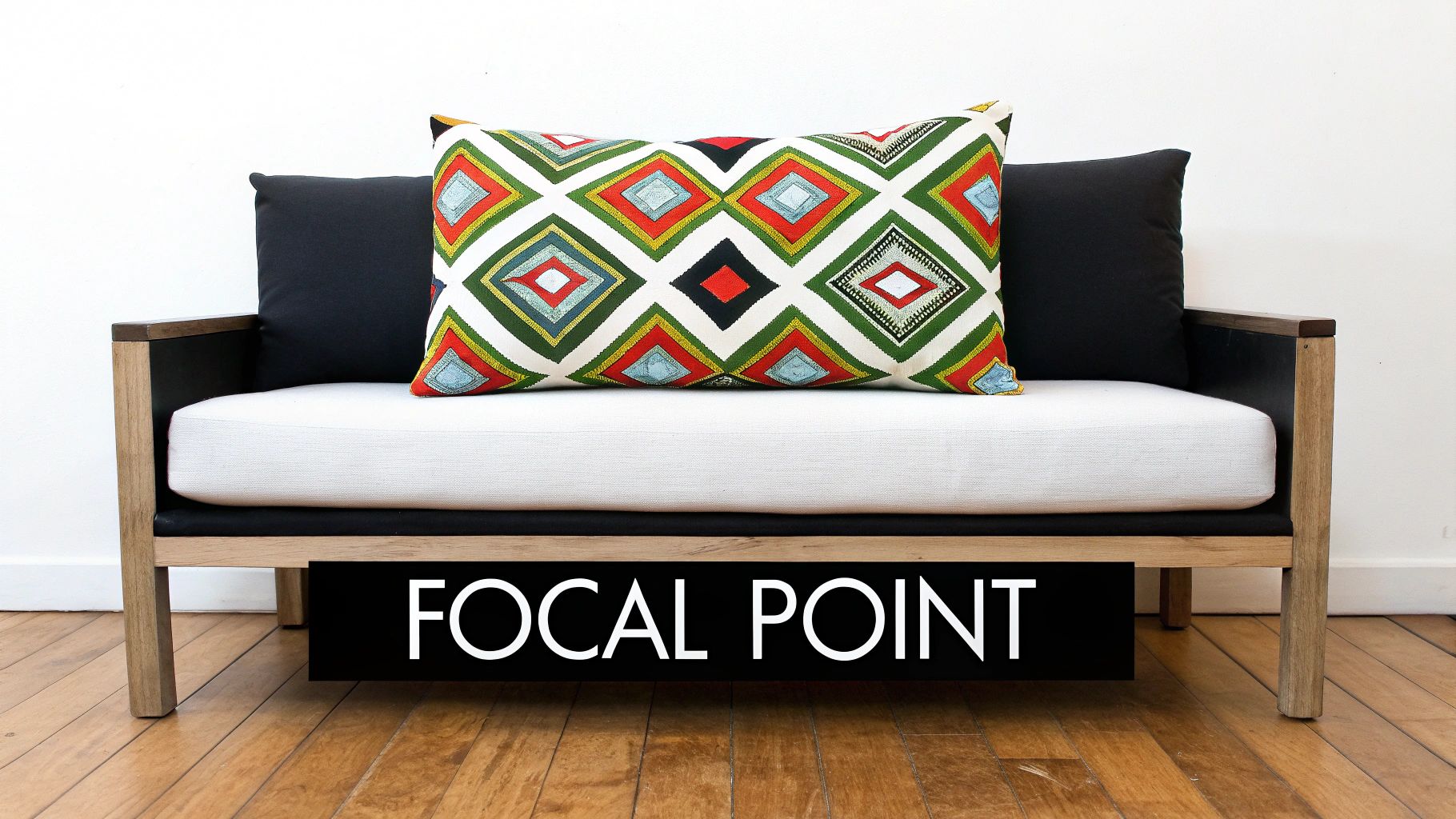7 Fresh Ideas for Decorating with Cushions in 2025

Cushions are far more than just comfortable additions to your sofa; they are the secret weapon of interior design. These versatile accents offer one of the quickest and most impactful ways to refresh a room, inject personality, and tie a decor scheme together. But mastering the art of decorating with cushions goes beyond simply tossing a few pillows on a couch. It involves a thoughtful blend of colour, texture, scale, and arrangement to create a look that is both intentional and effortlessly chic.
This guide moves beyond the basics, providing you with seven expert strategies to elevate your approach. We will explore practical, actionable techniques that deliver professional results. You will learn how to confidently mix patterns, leverage textures for depth, and use strategic placement to transform the feel of any space.
Whether you're revitalising a living room, adding warmth to a bedroom, or styling a commercial space, these techniques will empower you to use cushions to their full potential. With custom, locally-made options from New Zealand brands, creating a personalised and sustainable look has never been easier. Prepare to transform your space, one perfectly placed cushion at a time.
1. The Rule of Odd Numbers: Creating Natural Asymmetry
One of the most foundational yet impactful principles in interior styling is the "rule of odd numbers." This technique involves arranging cushions in odd-numbered groups, such as three, five, or seven, to create a more dynamic and visually appealing layout. Even-numbered arrangements often produce a rigid, overly symmetrical look that can feel static and staged. In contrast, odd numbers encourage the eye to move across the arrangement, fostering a sense of flow and effortless sophistication.
This principle is a cornerstone of professional styling because it provides a simple framework for successfully layering different sizes, textures, and patterns. By breaking perfect symmetry, you craft a look that feels more organic, curated, and lived-in. This approach is highly versatile, working just as effectively in a minimalist living room as it does in a vibrant, maximalist commercial space. For anyone looking to elevate their skills in decorating with cushions, mastering this rule is the perfect starting point.

How to Apply the Rule of Odds
Implementing this rule is straightforward and can be adapted to any piece of furniture. The goal is to create balance without perfect mirroring.
- For a Standard Sofa (Three Cushions): This is the classic application. Place two larger, coordinating cushions at either end of the sofa, then add a third, smaller or distinctly patterned cushion in the centre. A popular combination is two 55cm squares with one 45cm x 60cm lumbar cushion.
- For a Sectional Sofa (Five Cushions): A larger sofa offers more room for creativity. A group of five allows you to play with scale and placement. Try arranging three cushions in one corner and two in the another. Mix sizes for depth, such as two 60cm cushions, two 50cm cushions, and one decorative bolster.
- For an Accent Chair (One Cushion): A single, bold statement cushion on an armchair is a perfect example of the rule of odds. It creates a powerful, singular focal point without overwhelming the piece of furniture.
Actionable Tips for Success
To get the most out of this technique when decorating with cushions, keep these practical tips in mind:
- Build from Back to Front: Start by placing your largest cushions at the back, typically in the corners, and then layer smaller ones in front.
- Maintain Visual Balance: While the number is odd, the overall composition should still feel balanced. Distribute colours and patterns thoughtfully to avoid making one side feel heavier than the other.
- Trust Your Eye: Use the rule as a guideline, not a strict command. After arranging your cushions, step back and assess. Sometimes, breaking the rule slightly achieves a better result for your specific space and furniture.
2. Mix and Match Textures: Engaging the Senses
Beyond colour and pattern, texture is a powerful tool in interior design that engages our sense of touch and adds sophisticated depth to any space. This technique involves combining cushions with different fabric textures and materials to create visual interest and tactile appeal. Layering smooth silk with rough linen, soft velvet with chunky knit, or adding woven and embossed elements transforms a simple arrangement into a rich, multi-sensory experience.
This approach is highly effective because it adds complexity and warmth without necessarily relying on bold colours or busy patterns. A monochromatic or neutral palette can feel incredibly dynamic and inviting when composed of a variety of textures. By carefully curating different material finishes, you can elevate your skills in decorating with cushions, creating a look that feels layered, luxurious, and thoughtfully designed.

How to Apply Textural Layering
The key to successfully mixing textures is to create contrast that feels intentional and balanced. The goal is to highlight the unique qualities of each material.
- For a Modern, Minimalist Look: On a sleek leather or neutral fabric sofa, combine textures that offer subtle contrast. For instance, pair a smooth, tightly woven linen cushion with a soft, bouclé or chunky knit one. This adds warmth and dimension while honouring a clean aesthetic.
- For a Bohemian or Eclectic Style: This style thrives on textural diversity. Feel free to mix velvet, faux fur, woven jute, and cushions with macramé or tassel details. The combination of refined and rustic materials creates a relaxed, well-travelled vibe.
- For a Luxurious Feel: To achieve a high-end, opulent look, focus on rich materials. Combine lustrous silk or satin cushions with deep-pile velvet and perhaps a delicate, embroidered linen. The interplay of sheen and matte finishes adds an immediate sense of elegance. You can learn more about how to incorporate these wild textiles on maakhome.co.nz into your design.
Actionable Tips for Success
To master textural play when decorating with cushions, consider these practical guidelines:
- Limit Your Palette: Stick to a maximum of three or four distinct textures in one arrangement to prevent visual chaos. A curated selection feels more impactful than an overwhelming mix.
- Consider the Context: Think about the room's function. In high-traffic family rooms, durable textures like thick cotton, woven fabrics, and sturdy linen are ideal. Reserve delicate materials like silk for more formal, less-used spaces.
- Balance with Pattern: Use texture to unify an arrangement that features multiple patterns. A consistent textural theme, such as all-natural fibres (linen, cotton, wool), can tie together different prints and colours harmoniously.
3. Strategic Colour Coordination: Harmonising Your Space
Effective colour coordination is one of the most powerful tools when decorating with cushions, transforming them from simple accessories into unifying elements that tie a room together. This technique moves beyond exact matching, instead employing colour theory principles to create a cohesive and sophisticated palette. By using complementary colours, analogous schemes, or the classic 60-30-10 rule, you can craft a look that feels both intentional and effortlessly chic.
This approach allows cushions to serve as versatile colour anchors, introducing accents that can be easily updated to refresh a room’s entire aesthetic. Whether adding a bold pop to a neutral base or layering shades for a rich, monochromatic feel, strategic colour use ensures your cushions enhance the overall design narrative. This method is favoured by design professionals for its ability to create harmony without sacrificing personality, making a space feel curated and complete.

How to Apply Strategic Colour Coordination
Using colour theory can elevate your cushion styling from haphazard to harmonious. The goal is to create a palette that feels balanced and visually pleasing.
- Complementary Pop: In a room with a predominantly neutral base, such as a grey sofa and white walls, introduce cushions in a bold, complementary colour. For example, vibrant yellow or rich terracotta cushions can add a powerful burst of energy and create a striking focal point.
- Monochromatic Depth: For a subtle yet sophisticated look, select cushions in various tones, tints, and shades of a single colour. On a navy blue sofa, you could layer cushions in powder blue, dusty slate, and deep indigo to create a rich, textured, and cohesive arrangement.
- Analogous Harmony: Choose colours that sit next to each other on the colour wheel for a serene and naturally harmonious scheme. For instance, pairing green cushions with blue and teal accents creates a calming, nature-inspired palette that is easy on the eyes.
Actionable Tips for Success
To master the art of colour coordination when decorating with cushions, focus on these practical strategies:
- Draw from Your Surroundings: Pull accent colours directly from existing elements in the room, such as a piece of art, a floor rug, or even the view from a window. This ensures your cushions feel integrated into the space.
- Use the 60-30-10 Rule: Apply this designer-favourite formula. Your room's dominant colour should be 60% (walls, large furniture), a secondary colour 30% (curtains, chairs), and your cushions can provide the final 10% accent pop.
- Test in Natural Light: Colours can look dramatically different depending on the time of day. Before committing, place your cushion choices on the furniture and observe them in morning, afternoon, and evening light. For more guidance, you can learn more about choosing colours to match your furniture for a perfectly balanced look.
4. Size and Scale Variation: Adding Depth and Rhythm
Moving beyond colour and pattern, mastering the art of size and scale variation is a crucial step in professional-level decorating with cushions. This design strategy involves deliberately mixing cushions of different dimensions to create a dynamic visual rhythm and prevent a flat, monotonous look. By combining standard squares with rectangular lumbars, circular bolsters, and even oversized floor cushions, you can build layers that add architectural interest, depth, and a sense of plush comfort.
This technique is frequently seen in high-end hotel styling and designer showrooms because it transforms a simple sofa or bed into a sophisticated, multi-dimensional feature. Instead of a uniform lineup, varying the scale creates a curated, inviting aesthetic that draws the eye and enhances the overall comfort of the space. It’s an effective way to make furniture feel more luxurious and thoughtfully styled.

How to Apply Size and Scale Variation
Implementing this strategy is about creating a deliberate hierarchy of shapes and sizes. The goal is to build a composition that feels balanced yet visually interesting.
- On a Sectional Sofa: A large sectional provides the perfect canvas. Start with two oversized 60cm or 65cm square cushions in the corners. Layer two slightly smaller 55cm squares in front of them, and finish with a single 30cm x 50cm lumbar cushion in the centre of one of the groupings for an asymmetrical touch.
- On a Bed or Daybed: Create a luxurious, hotel-style look by mixing proportions. Place two large European pillows (65cm x 65cm) against the headboard, followed by two standard pillows. Finish with a long, single bolster cushion (e.g., 35cm x 90cm) or a small decorative cushion in front.
- With Floor Cushions: Integrate oversized floor cushions (e.g., 70cm squares) to extend the layered look beyond the sofa. This adds a casual, bohemian feel and provides extra seating, connecting the furniture to the floor and making the entire space feel more cohesive.
Actionable Tips for Success
To effectively use different sizes when decorating with cushions, keep these practical points in mind:
- Start Large, Layer Small: Always place your largest cushions at the back and work your way forward with progressively smaller sizes. This creates a clear sense of depth.
- Ensure Noticeable Differences: For the variation to be effective, aim for at least a 5-10cm difference between cushion sizes. This ensures each layer is distinct. For more guidance, our cushion size guide offers a detailed breakdown.
- Consider Furniture Proportions: The scale of your cushions should complement the scale of your furniture. A delicate armchair needs smaller cushions, while a deep, oversized sofa can handle larger, more dramatic pieces.
- Use Lumbars Functionally: A rectangular lumbar pillow is not just a stylistic choice; it adds excellent lower back support, making it a practical and aesthetic addition to any arrangement.
5. Pattern Mixing Mastery
One of the most sophisticated skills in decorating with cushions is pattern mixing. This advanced technique involves layering different patterns, such as florals, geometrics, and stripes, to create a space that feels curated, dynamic, and deeply personal. When done correctly, it moves beyond simple coordination to tell a visual story, adding depth and character. A chaotic clash is avoided by adhering to a few key principles, resulting in a look that feels intentionally eclectic rather than accidental.
This approach is championed by designers like Kit Kemp and is a hallmark of styles ranging from traditional English country house to modern bohemian. It transforms a simple sofa or bed into a canvas for artistic expression. For those looking to create a truly unique and memorable interior, mastering the art of mixing patterns is an essential step that showcases confidence and a strong design sensibility.
How to Apply Pattern Mixing
The key to successful pattern mixing is creating harmony through a common thread, usually colour, while varying the scale and style of the prints.
- For a Classic, Elegant Look: Combine traditional patterns with varying scales. For example, pair a large-scale floral print cushion with a smaller, subtle pinstripe, and a solid-coloured cushion in a rich texture like velvet. The shared colour palette ties the disparate patterns together.
- For a Modern, Eclectic Vibe: Be bold by mixing different design genres. Try combining a classic paisley print with a contemporary abstract design and a small-scale geometric dot pattern. As long as they share one or two core colours, the combination will feel cohesive and exciting.
- For a Subtle, Textured Approach: Mix patterns that are low-contrast or monochromatic. Think of a white cushion with a grey toile pattern, paired with a charcoal-and-white chevron print and a solid light grey linen cushion. This creates visual interest without overwhelming the senses.
Actionable Tips for Success
To confidently mix patterns when decorating with cushions, use these professional strategies to guide your choices:
- Vary the Scale: This is the most crucial rule. Combine large, medium, and small-scale patterns. If all patterns are the same size, they will compete for attention and create a jarring effect.
- Establish a Cohesive Colour Palette: Choose a palette of two to three colours and ensure each patterned cushion contains at least one of them. This creates a visual link that unifies the arrangement.
- Incorporate Solids: Use solid-coloured cushions to act as a visual break. These "resting places" for the eye prevent the arrangement from becoming too busy and help to ground the bolder patterns.
6. Seasonal Rotation Strategy
A seasonal rotation strategy treats cushions as versatile, interchangeable accessories, allowing you to effortlessly refresh your space's look and feel throughout the year. This practical approach involves curating different sets of cushion covers to align with the changing seasons, holidays, and moods. By swapping out covers, you can dramatically alter a room's ambiance without the cost or commitment of a major renovation, making it a highly effective tool for both homes and commercial spaces.
This method, popularised by lifestyle brands like Pottery Barn and deeply embedded in philosophies like Scandinavian hygge, is perfect for keeping your décor feeling current and intentional. It’s a key technique in professional styling because it adds a layer of thoughtful curation that resonates with the time of year. For anyone looking to master decorating with cushions, this strategy provides a simple yet powerful way to keep interiors dynamic and engaging.
How to Apply a Seasonal Strategy
Implementing this approach centres on building a capsule collection of cushion covers that can be swapped to reflect the outdoor environment.
- Spring/Summer Palette: Embrace the warmer months with light, airy fabrics and vibrant colours. Think crisp linens, cool cottons, and fresh floral or botanical prints. Bright yellows, sky blues, and soft greens can make a space feel open and cheerful. A nautical theme with navy and white stripes is another classic summer choice.
- Autumn/Winter Palette: As the weather cools, transition to rich textures and warm, inviting tones. Velvets, faux furs, and chunky knits add instant cosiness. Opt for deep oranges, earthy browns, rich burgundies, and forest greens. Traditional patterns like tartan or plaid work wonderfully to create a snug, welcoming atmosphere.
Actionable Tips for Success
To make your seasonal cushion rotation seamless and cost-effective, follow these practical tips:
- Invest in Quality Inserts: The foundation of this strategy is high-quality cushion inserts. Purchase durable, well-filled inserts in standard sizes that you can use year-round with different covers.
- Plan Your Purchases: A great way to build your collection is to buy covers during end-of-season sales. This allows you to acquire high-quality pieces for the following year at a reduced price.
- Store Properly: Protect your off-season cushion covers by storing them in breathable fabric bags. This prevents moisture build-up, dust, and potential discolouration, ensuring they look great when you bring them out again.
7. Focal Point Creation
While cushions are often used as complementary accessories, a powerful technique is to use them to create a deliberate focal point. This approach shifts the cushion from a supporting role to the star of the show, using it to anchor a room’s design scheme. Instead of blending in, a focal point cushion is chosen specifically for its ability to draw the eye with a bold colour, striking pattern, unique shape, or luxurious material that commands attention and defines the room’s style.
This method is championed by designers like Jonathan Adler, known for his graphic aesthetic, and Kelly Wearstler, who embraces maximalist luxury. It’s an effective way of decorating with cushions to inject personality and a clear design statement into a space. By making one element the hero, you create a sense of intention and confidence, preventing the overall décor from feeling bland or unfocused. A single, well-chosen statement cushion can set the tone for an entire seating area.
How to Create a Focal Point
Implementing this technique is about making a deliberate, bold choice that contrasts with its surroundings to capture attention.
- On a Minimalist Sofa: Place a single, oversized geometric print cushion on a neutral-coloured sofa. The contrast between the simple backdrop and the dynamic pattern creates an immediate visual anchor.
- On Neutral Furniture: Use a pair of bright, jewel-toned velvet cushions on a beige or grey armchair or sofa. The rich colour and luxe texture provide a pop of energy and sophistication.
- As a Conversation Piece: Introduce cushions with unique shapes, such as round, triangular, or even novelty forms. These non-traditional shapes break visual monotony and act as functional art pieces.
Actionable Tips for Success
To ensure your focal point cushion enhances your space without overwhelming it, consider these practical tips:
- Limit the Focus: Stick to one primary focal point per seating area to avoid visual competition and clutter. If you have a statement cushion on a sofa, keep the cushions on nearby chairs more subdued.
- Ensure Proper Proportion: The focal cushion should be appropriately scaled to the furniture it sits on. An oversized cushion on a small chair can look awkward, while a tiny cushion on a large sectional will get lost.
- Balance with Simpler Elements: Surround your bold focal cushion with simpler, more neutral supporting cushions. This allows the statement piece to shine and creates a balanced, cohesive look. You can learn more about how to decorate with cushions on maakhome.co.nz for additional inspiration.
7 Cushion Decorating Strategies Comparison
| Technique | Implementation Complexity 🔄 | Resource Requirements ⚡ | Expected Outcomes 📊 | Ideal Use Cases 💡 | Key Advantages ⭐ |
|---|---|---|---|---|---|
| The Rule of Odd Numbers | Low - simple arrangement principle | Minimal - just cushions | Dynamic, natural visual interest | Casual to formal seating, spaces needing organic flow | Professional look, easy to apply, flexible placement |
| Mix and Match Textures | Medium - requires texture selection | Moderate - varied fabric types | Sophisticated depth and tactile engagement | Layered, sensory-rich spaces, luxury and comfort focused | Adds richness, year-round interest, tactile variety |
| Strategic Color Coordination | Medium - color theory knowledge | Low to moderate - cushion color variations | Harmonious, cohesive room color story | Rooms needing color unity, seasonal color updates | Cost-effective mood changer, visual cohesion |
| Size and Scale Variation | Medium - cushion size planning | Moderate - multiple cushion sizes | Visual rhythm, layered interest, comfort | Styling layered lounges, improving seating comfort | Professional look, varied comfort, architectural interest |
| Pattern Mixing Mastery | High - advanced design skills | Moderate to high - assorted patterned cushions | Dynamic, personality-filled aesthetics | Bold, curated spaces, personal style expression | Sophisticated look, masks wear, strong personal style |
| Seasonal Rotation Strategy | Low to medium - seasonal planning | Moderate to high - multiple cushion sets | Fresh decor feel, adaptable ambiance | Seasonal decorating, trend experimentation | Keeps decor current, cost-effective refresh |
| Focal Point Creation | Medium - bold statement choices | Moderate - unique or luxury cushions | Immediate visual impact, room anchor | Neutral rooms needing standout elements | High impact, personality expression, easy focal changes |
Your Space, Reimagined: Putting Your Cushion Plan into Action
You are now equipped with a complete toolkit for transforming any space with the artful power of cushions. We have moved far beyond the idea of these items as mere afterthoughts. Instead, we have seen how they can become the central characters in your interior design story, capable of introducing personality, comfort, and sophisticated style into any room. Effective decorating with cushions is a skill that balances creative expression with foundational design principles.
By embracing the seven core strategies detailed in this guide, you have a clear roadmap to success. You can now confidently arrange cushions using the 'Rule of Odd Numbers' to create visual interest and avoid static symmetry. You understand how to layer diverse materials, from plush velvet to rustic linen, to build a rich, tactile experience that invites touch and adds depth. The fear of clashing patterns or colours is a thing of the past; you now have the principles for 'Pattern Mixing Mastery' and 'Strategic Colour Coordination' at your disposal.
Key Takeaways for a Transformed Space
Let's recap the most impactful insights that will elevate your approach:
- Intention is Everything: A deliberate choice of size, scale, and placement transforms a simple sofa into a curated design statement.
- Texture Adds Dimension: Mixing textures is not just about looks; it’s about creating a multi-sensory experience that makes a space feel richer and more luxurious.
- Embrace Dynamic Change: Your home is not a static museum. Implementing a 'Seasonal Rotation Strategy' keeps your decor feeling fresh, current, and exciting throughout the year.
The true value in mastering these techniques lies in their combined effect. A single, well-chosen cushion can add a pop of colour. However, a thoughtfully curated collection that plays with odd numbers, varied textures, complementary patterns, and strategic sizing can redefine an entire room's atmosphere. It’s the difference between simply filling a space and truly designing it.
Your Next Steps
The journey to a beautifully styled home begins with a single step. Don't feel pressured to overhaul everything at once. Start by assessing one area, perhaps the living room sofa or the master bed. Identify what's missing. Does it need a vibrant colour? A cosy texture? A bold pattern to serve as a focal point?
Use the principles from this article as your guide, not as rigid rules. The most compelling interiors are authentic and reflect the unique tastes of those who inhabit them. Allow yourself to experiment. Mix that floral with a geometric print. Place an oversized lumbar in front of two smaller squares. The beauty of decorating with cushions is its low-risk, high-reward nature. You can completely reimagine your space without a significant commitment of time or budget, empowering you to become the confident creator of your own environment.
Ready to bring your unique vision to life with bespoke, locally made quality? Explore the curated collections or upload your own design at Maak Home. With their sustainable, on-demand digital printing, you can source the perfect cushions to match your newly-found decorating confidence. Maak Home is your partner in creating a space that is truly your own.









